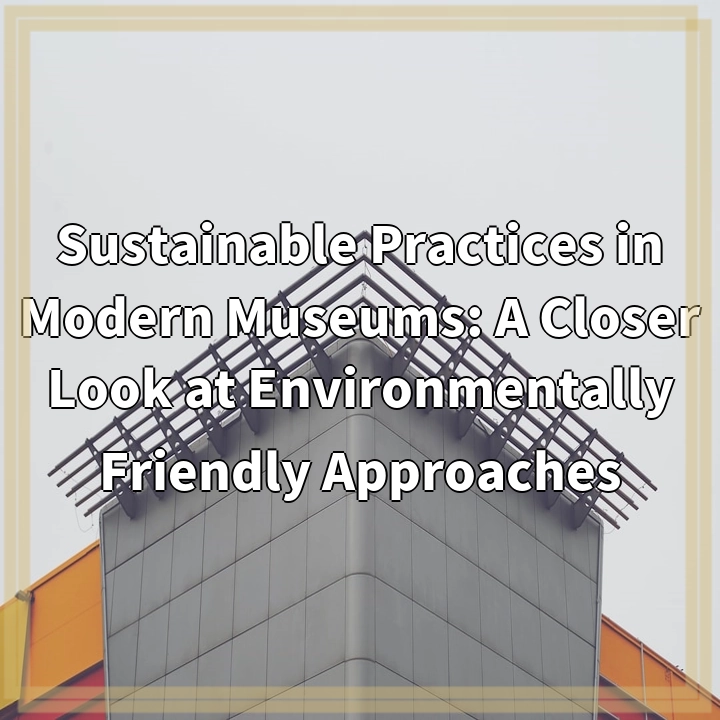
What it is:
Sustainable practices in modern museums aim to reduce the environmental impact and promote the conservation of resources within these cultural institutions. It involves implementing strategies that minimize energy consumption, waste generation, and carbon emissions, while also considering the preservation and protection of artworks and artifacts. By adopting environmentally friendly approaches, museums can contribute to creating a more sustainable future for both the cultural and natural heritage they house.
Real-World Problems Associated with Sustainable Practices in Modern Museums:
1. Funding Constraints: One of the major challenges faced by museums is securing adequate funding to invest in sustainable practices. Retrofitting buildings, upgrading systems, and implementing renewable energy solutions can be expensive, requiring financial commitments that museums may struggle to secure.
2. Preservation vs. Sustainability: There can be a perceived conflict between conserving delicate artworks and implementing sustainable practices. For example, maintaining specific temperature and humidity levels in exhibition spaces to protect artifacts may result in increased energy consumption. Striking a balance between preservation and sustainability is a complex challenge that museums need to address.
3. Limited Access to Expertise: Implementing sustainable practices in museums often requires specialized knowledge and expertise. However, not all museums may have access to sustainability professionals or consultants who understand the unique requirements and constraints of cultural institutions.
4. Complex Building Structures: Many museums occupy historic buildings with intricate architectural designs. Retrofitting such structures to improve energy efficiency and reduce environmental impact can be challenging due to the limitations posed by the building’s design and historical significance.
5. Public Awareness and Engagement: Encouraging public support and engagement in sustainable practices is crucial but can be difficult to achieve. Museums need to effectively communicate and educate visitors about their sustainability efforts, inspiring them to make eco-friendly choices.
6. Collection Management: Storage and preservation of collections demand significant energy consumption. Developing sustainable solutions for collection management, such as efficient storage systems and conservation technologies, can be an ongoing challenge for museums.
7. Waste Management: Museums produce various types of waste, including packaging materials, exhibition displays, and other materials related to conservation and maintenance. Implementing effective waste management programs and recycling initiatives is essential to minimize environmental impact.
By addressing these real-world problems, museums can work towards adopting more sustainable practices and serve as leaders in environmental stewardship within the cultural sector.

Solutions to Real-World Problems Associated with Sustainable Practices in Modern Museums:
1. Securing Funding: Museums can explore various avenues for funding, such as government grants, corporate sponsorships, and partnerships with sustainability-focused organizations. Additionally, they can incorporate sustainability practices into their strategic plans to increase the chances of securing dedicated funding.
2. Integrating Preservation and Sustainability: Museums can collaborate with experts in conservation and sustainable design to find innovative solutions that strike a balance between preserving artifacts and minimizing environmental impact. This may involve implementing energy-efficient climate control systems, utilizing sustainable materials for exhibition displays, and employing best practices for environmental management.
3. Collaboration and Knowledge Sharing: Museums can work together and share their experiences and knowledge in implementing sustainable practices. Collaborative networks and professional associations can facilitate the exchange of ideas, resources, and expertise to overcome the limited access to sustainable professionals.
4. Adaptive Design: Museums can explore creative design solutions that respect the historical and architectural significance of their buildings while also improving energy efficiency. This may involve retrofitting and upgrading infrastructure with sustainable technologies, such as solar panels or smart energy management systems.
5. Public Engagement and Education: Museums can enhance public awareness and engagement by showcasing their sustainability efforts through exhibits, guided tours, and educational programs. By highlighting the connection between cultural heritage and environmental sustainability, museums can inspire visitors to adopt eco-friendly practices in their own lives.
6. Innovative Collection Management: Museums can invest in research and development to find sustainable alternatives for collection storage, such as energy-efficient climate-controlled storage facilities and low-impact preservation techniques. They can also explore digitization and virtual exhibitions as sustainable alternatives to conserve and share their collections.
7. Effective Waste Management: Implementing comprehensive waste management systems, including recycling, composting, and responsible disposal of hazardous materials, can significantly reduce the environmental impact of museums. Collaboration with local authorities and waste management organizations can help museums develop effective waste management strategies.
By implementing these solutions, modern museums can lead the way in adopting sustainable practices and contribute to a more environmentally conscious cultural sector.















